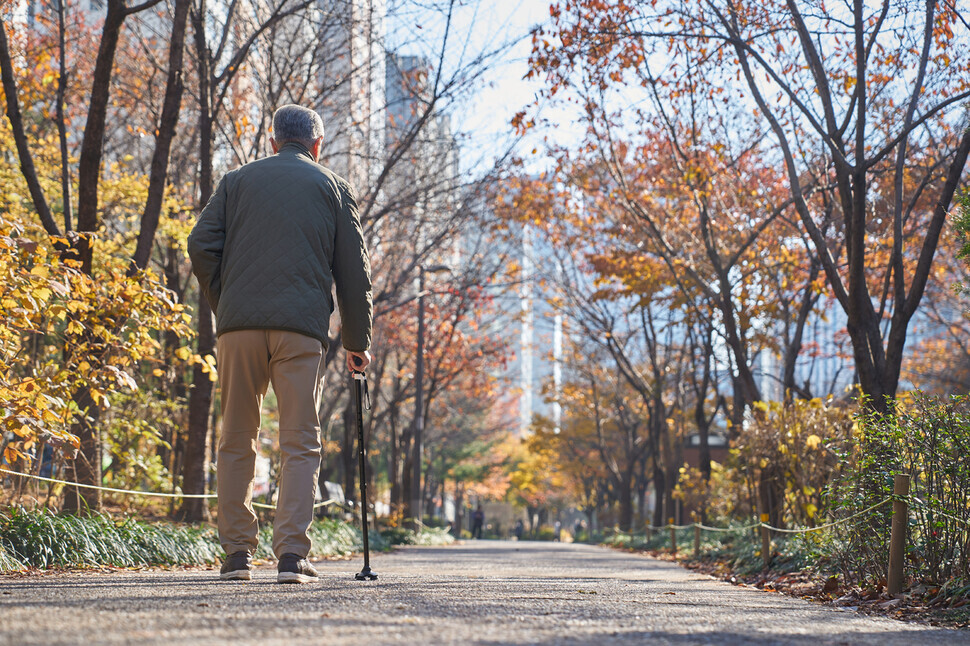hankyoreh
Links to other country sites 다른 나라 사이트 링크
South Korea now has more over-70s than 20-somethings

In 2023, the number of South Koreans aged 70 and over outnumbered those in their 20s. This was the first time this phenomenon was recorded since resident registration population data began being compiled.
While the country saw a continued decline in the working-age population and those planning on entering elementary school, lone seniors have come to make up the majority of households, revealing the stark reality of South Korea’s aging population.
Resident registration population data for 2023 released by the Ministry of the Interior and Safety on Wednesday showed 51.329 million people registered residents in Korea, showing a 113,709-person decrease compared to 2022.
On the other hand, the number of households has steadily increased, reaching 23.491 million, a jump of 200,037 from 2022.
The average number of members in a household was 2.15, with the largest number of households being those in their 70s living alone, followed by those in their 60s living alone.
Figures showed the declining birth rate and aging population becoming more and more pronounced at a speedy rate.
For the first time, the number of people aged 70 and over (6,319,402) surpassed the number of people in their 20s (6,194,886). In 2023, there were 9.73 million people aged 65 and older (19.0%), 463,210 more than in 2022, but there were 35.93 million people in the 15-64 working age group (70.0%), 35,097 fewer than in 2022.
The UN defines an “aging society” as a country where people aged 65 or older account for 7% or more of the population. In an “aged society,” this cohort constitutes 14% or more of the population. In a “super-aged society,” the share is 20% or higher.
South Korea is not far from becoming a super-aged society. The number of students expected to begin elementary school this year (6 years old) is 364,740, as opposed to 413,162 last year. That’s a decrease of 48,422 students in just one year.
Looking at individual regions respectively, people aged 65 or older accounted for more than 20% of the local population in the provinces of South Jeolla and North Jeolla, North and South Gyeongsang, Gangwon, and South and North Chungcheong, as well as in the city of Busan, making these regions already super-aged.
The local populations of Daegu, Seoul, Jeju Island, Daejeon, Incheon, Gwangju, Ulsan and Gyeonggi Province are all aged societies. Only the city of Sejong is an aging society.
The concentration of the country’s population in the greater Seoul area has also gotten worse. Last year, the population living in the greater capital area was 26,014,265, or 50.7% of the total population as opposed to the 25,311,064 (49.3%) living outside the Seoul metro area. That’s a difference of 703,201 people. The greater Seoul area’s population first surpassed the rest of the country in 2019, and the disparity continues to grow every year.
By Son Ji-min, staff reporter
Please direct questions or comments to [english@hani.co.kr]

Editorial・opinion
![[Editorial] Intensifying US-China rivalry means Seoul must address uncertainty with Beijing sooner than later [Editorial] Intensifying US-China rivalry means Seoul must address uncertainty with Beijing sooner than later](https://flexible.img.hani.co.kr/flexible/normal/500/300/imgdb/original/2024/0517/8117159322045222.jpg) [Editorial] Intensifying US-China rivalry means Seoul must address uncertainty with Beijing sooner than later
[Editorial] Intensifying US-China rivalry means Seoul must address uncertainty with Beijing sooner than later![[Column] When ‘fairness’ means hate and violence [Column] When ‘fairness’ means hate and violence](https://flexible.img.hani.co.kr/flexible/normal/500/300/imgdb/original/2024/0516/7417158465908824.jpg) [Column] When ‘fairness’ means hate and violence
[Column] When ‘fairness’ means hate and violence- [Editorial] Yoon must stop abusing authority to shield himself from investigation
- [Column] US troop withdrawal from Korea could be the Acheson Line all over
- [Column] How to win back readers who’ve turned to YouTube for news
- [Column] Welcome to the president’s pity party
- [Editorial] Korea must respond firmly to Japan’s attempt to usurp Line
- [Editorial] Transfers of prosecutors investigating Korea’s first lady send chilling message
- [Column] Will Seoul’s ties with Moscow really recover on their own?
- [Column] Samsung’s ‘lost decade’ and Lee Jae-yong’s mismatched chopsticks
Most viewed articles
- 1[Editorial] Transfers of prosecutors investigating Korea’s first lady send chilling message
- 2[Exclusive] Unearthed memo suggests Gwangju Uprising missing may have been cremated
- 3S. Korea “monitoring developments” after report of secret Chinese police station in Seoul
- 4[Editorial] Intensifying US-China rivalry means Seoul must address uncertainty with Beijing sooner t
- 5Xi, Putin ‘oppose acts of military intimidation’ against N. Korea by US in joint statement
- 6Truth commission confirms Korean War killings by soldiers and police
- 7[Editorial] South Korean women are mobilizing in unprecedented ways
- 8Calls for gender-equality continue as demonstrations target President Moon
- 9[Column] “Hoesik” as ritual of hierarchical obedience
- 10Why Kim Jong-un is scrapping the term ‘Day of the Sun’ and toning down fanfare for predecessors